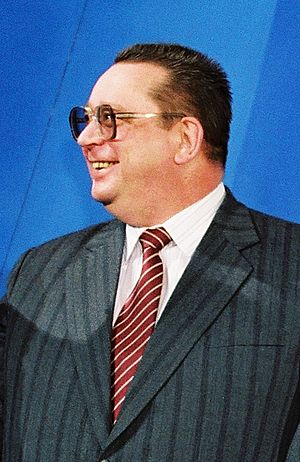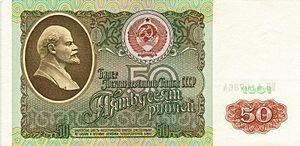Valentin Pavlov facts for kids
Quick facts for kids
Valentin Pavlov
Валентин Павлов |
|
|---|---|

Pavlov in 1991
|
|
| Prime Minister of the Soviet Union | |
| In office 14 January 1991 – 28 August 1991 |
|
| President | Mikhail Gorbachev |
| Deputy |
Vladimir Velichko
Vitaly Doguzhiev |
| Preceded by | Nikolai Ryzhkov |
| Succeeded by | Ivan Silayev |
| Minister of Finance | |
| In office 17 July 1989 – 26 December 1990 |
|
| Preceded by | Boris Gostev |
| Succeeded by | Vladimir Yefimovich Orlov |
| Chairman of the State Committee on Prices | |
| In office 15 August 1986 – 7 June 1989 |
|
| Preceded by | Nikolai Glushkov |
| Succeeded by | Vyacheslav Senchagov |
| Personal details | |
| Born | 27 September 1937 Moscow, Russian SFSR, Soviet Union |
| Died | 30 March 2003 (aged 65) Moscow, Russia |
| Resting place | Pyatnitskoye Cemetery |
| Nationality | Soviet and Russian |
| Political party | Communist Party of the Soviet Union (1962-1991) |
| Alma mater | Moscow Finance Institute |
Valentin Sergeyevich Pavlov (Russian: Валéнтин Серге́евич Па́влов; 27 September 1937 – 30 March 2003) was a Soviet official. After the Soviet Union ended, he became a banker in Russia.
Born in Moscow, Pavlov started his career in the Ministry of Finance in 1959. He later led the Financial Department of the State Planning Committee. During the time of Mikhail Gorbachev, Pavlov became the head of the State Committee on Prices. He then served as Minister of Finance.
In 1991, Pavlov became the Prime Minister of the Soviet Union. As Prime Minister, he started a big money change, known as the Pavlov reform. He said this was to stop money from coming into the Soviet Union from other countries. This statement was later found to be true.
In June 1991, Pavlov wanted more power for the Prime Minister and the Cabinet of Ministers. When this did not happen, he joined a plan to remove Gorbachev from power. In August, he took part in the 1991 Soviet coup d'état attempt. This attempt tried to stop the Soviet Union from breaking apart. Pavlov was arrested for his role in the coup. After his release, he worked in banking in Russia. Some people see him as the last official Soviet head of government.
Contents
Early Life and Career
Valentin Pavlov was born in Moscow on 27 September 1937. He finished his studies at the Moscow Finance Institute in 1958. He began working as a government economist for the Ministry of Finance in 1959. In 1962, he joined the Communist Party of the Soviet Union.
Early in his career, he also worked for the Ministry of Finance of the Russian Soviet Federative Socialist Republic (RSFSR). In 1979, Pavlov started working for the State Planning Committee. He became a member of its board in 1981. He was the head of the State Planning Committee's Finance Department. This department looked after all parts of the country's planned economy. From January to August 1986, he was the First Deputy Minister of Finance.
On 15 August 1986, Pavlov was made Chairman of the State Committee on Prices. He held this job until 7 June 1989. During this time, and later as Minister of Finance, Pavlov supported a plan to change prices. This plan was suggested by Nikolai Ryzhkov, who was the Chairman of the Council of Ministers.
In 1989, Pavlov became the Minister of Finance in Ryzhkov's government. His time in this role was not seen as controversial. He was the only minister in Ryzhkov's government who was also part of the Presidium of the Council of Ministers.
Pavlov supported making the Soviet economy more like a market economy. He saw a quick increase in the Soviet money supply and the inflation it caused. Pavlov also set the exchange rate for the rouble against the American dollar on the Soviet black market. In 1993, he said that he had misled some Western banks about the Soviet Union's gold reserves.
Becoming Prime Minister
Nikolai Ryzhkov resigned in December 1990 after having a heart attack. Pavlov was then chosen for the new job of Prime Minister. He became the chairman of the Cabinet of Ministers. On 14 January, he and his two First Deputy Prime Ministers, Vladimir Velichko and Vitaly Doguzhiev, were approved by the Supreme Soviet of the Soviet Union.
When he became Prime Minister, Pavlov was seen as a conservative. The Soviet press called him a "bold and complex man." They said he was against a full market economy. But he also believed the Soviet Union treated workers worse than capitalist countries. One of his first actions was to move the government's headquarters. He moved the Cabinet of Ministers from the Moscow Kremlin to a new building. This was done to make his position stronger.
1991 Money Reform
The Soviet money reform of 1991 is often called the Pavlov reform. It was the last big money change before the Soviet Union broke apart. It started on 22 January 1991. The goal was to take money out of circulation. This money would then be used to make more consumer goods, which were hard to find.
Pavlov said the government believed money was being sent to the Soviet Union from other countries. He said this was causing inflation. At the time, the Soviet press made fun of this idea. However, three years later, it was proven true. Mikhail Gorbachev then signed an order. This order stopped the Soviet financial system from taking banknotes issued in 1961. It also included 50-rouble and 100-rouble banknotes from 1991.
On 23 January 1991, the government limited monthly bank withdrawals to 500 rubles. They said this was to freeze the money of corrupt officials and criminals.
Under Pavlov's orders, the government made 40 percent of prices free on 1 January 1991. They also added a 5% sales tax. Prices for consumer goods could now be negotiated between producers and sellers. However, this reform did not work well. The Union Republics did not always follow Pavlov's orders. Also, local monopolies set their own high prices for luxury items.
Soviet citizens had only three days, from 23 to 25 January, to exchange their old 50 and 100 rouble banknotes. People could exchange money at banks, workplaces, and post offices. Many people waited in long lines. This reform hurt people who had saved a lot of money. Some lost as much as 15,000 to 30,000 rubles overnight.
The reform was not successful. The government only took 14 billion rubles out of circulation. They had wanted to take out 81.5 billion rubles. So, the Pavlov reform did not stop inflation. Prices for things like food and transport went up by 100–300 percent. The Soviet standard of living dropped sharply. The government's budget deficit grew by about 20–30 percent of GNP. After the reform, inflation was over 50 percent every month.
Coup Attempt
In June 1991, Pavlov felt that the Prime Minister's job had too little power. He found out that Gorbachev planned to replace him. Pavlov then spoke to the Supreme Soviet of the Soviet Union. He was nervous and told them about the failing Soviet economy.
Pavlov blamed the problems on a "War of Laws" between the Supreme Soviet of the Soviet Union and the Supreme Soviet of the Russian Soviet Federative Socialist Republic (RSFSR). He said this could be fixed by declaring a state of emergency across the Soviet Union.
Pavlov believed the country's problems would not be solved as long as Gorbachev had so much power. He wanted to transfer power from the President to the Prime Minister and the Cabinet of Ministers. He wanted the Cabinet to be able to make economic decisions without the President's approval. He even created a five-point plan for this.
The Soyuz parliamentary group supported Pavlov. They wanted an immediate vote on the issue. The Chairman of the Supreme Soviet, Anatoly Lukyanov, promised to tell Gorbachev about the vote. However, Ivan Laptev, who supported Gorbachev, tried to stop the vote. He asked for statements from the KGB, the Ministry of the Interior, and the Ministry of Defence. Laptev believed Pavlov would have won the vote if it had happened. The Soviet secret police and military generally wanted to strengthen the government.
Soon after, Jack Matlock, the United States ambassador, told Gorbachev about a possible coup. Gorbachev became worried when he heard about strange troop movements near Moscow. On 21 June, Gorbachev spoke to the Supreme Soviet. He said there were no disagreements between him and Pavlov. Even though Gorbachev kept his position, his power was weakening. He managed to reverse the extra powers given to the Cabinet of Ministers.
The power struggle continued. On July 29, 1991, Gorbachev promised Boris Yeltsin and Nursultan Nazarbayev that Pavlov would be removed. He also planned to remove Dmitry Yazov, the Minister of Defence, and Vladimir Kryuchkov, the Chairman of the KGB. Nazarbayev was to become the new Prime Minister.
August Coup
The 1991 Soviet coup d'état attempt, also called the August Coup, happened because the Soviet Union was slowly breaking apart. Gorbachev's reforms and Yeltsin's push for an independent Russia were part of this. A new treaty was being prepared. It would give more power to the republics. This would make the government's control over the economy even weaker. Pavlov saw a draft of this treaty on 12 August. He made sure it was published in the Moscow News on 14 August.
Pavlov was against giving more power to the republics. He was a key person in setting up the State Committee for the State of Emergency in August 1991. This committee wanted to keep the Soviet Union as a strong, central union. The Emergency Committee was led by Gennady Yanayev, the Vice President of the Soviet Union. Other leaders included Boris Pugo, the Interior Minister, and Dmitry Yazov, the Defence Minister. They were determined to remove Gorbachev.
Vladimir Kryuchkov, the KGB Chairman, told Pavlov about the coup on 18 August. This was one day before it began. Kryuchkov asked Pavlov to meet the other plotters at the Moscow Kremlin. On 19 August, Pavlov and the others appeared on live television. They told the Soviet people that Gorbachev was unwell. As the day went on, Pavlov seemed confused and repeated himself. He later said he had been drinking the day before. On the same day, the other plotters decided to remove Pavlov. They sent him to his home, where his wife took care of him.
Like the others, Pavlov was arrested after the coup failed. He was later hospitalized due to high blood pressure while in custody. He was released in January 1993. In 1994, the Russian State Duma granted him amnesty.
Later Life
After his release, Pavlov became a director at the commercial bank Chasprombank from 1994 to 1995. He left this job at the request of the bank's board. In February 1996, the bank's license was taken away for breaking banking laws.
Pavlov then worked as an advisor to Promstroibank from 1996 to 1997. In 1998, he also became a vice president of an American company called Business Management Systems. He also worked as a vice president for the Free Economic Society and the International Academy of Management. Later, he led a department of the International Union of Economists.
Valentin Pavlov died in Moscow on 30 March 2003. He was buried on 2 April at Pyatnitskoye Cemetery.
Images for kids
See also
 In Spanish: Valentín Pávlov para niños
In Spanish: Valentín Pávlov para niños



